This first table shows the BP-NLS360’s W/10ΔT numbers in a quick glance chart format.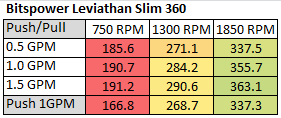 Using this data we can effectively show percentage gains/losses relative to a reference point. It’s an interesting way to show gains/losses while changing a variable.
Using this data we can effectively show percentage gains/losses relative to a reference point. It’s an interesting way to show gains/losses while changing a variable.
So, let’s focus on 1300 RPM as our reference and see how much gain or loss in performance we get by changing fan speed up and down.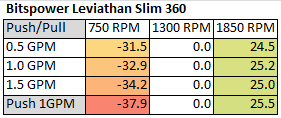
In our Tuning Table for Flow Rate Variance with 1.0 GPM as a reference point, we again see little variance between results when changing flow rates at the same fan speed.
The next three tables have specific reference points set for gain and loss comparison.
1.0 GPM @ 1300 RPM reference point.
0.5 GPM @ 750 RPM reference point.

1.5 GPM @ 1850 RPM reference point.
So from the data above we’re getting a good idea of how the BP-NLS360 radiator performs relative to itself. But there is a large selection of 360mm radiator models to choose from, so let’s put the BP-NLS360’s results into some comparison charts.
As with our previous Slim 360mm radiator reviews, we’ll only comment and score on comparisons made against other Slim 360s. For those interested we’ll also make available the data against all the 360mm models, but they will be spoilered and not commented on.
There is a LOT of data which make up our charts and previously we have not published all of it. After receiving requests for certain data to be included we’ve decided to now include even more plots. Aware that we are at data saturation point and are at risk of the page becoming information overkill – we’ll try and keep things somewhat simplified by applying spoilers on some plots from now on. All the data will still be available, just means a few extra click for those who wish to analyze everything.
Push Only Data vs Competition
Focusing on the Push Only results for now, we’ll get to the Push/Pull data later.
Let’s start with 750 RPM and see how the BP-NLS360 compares.
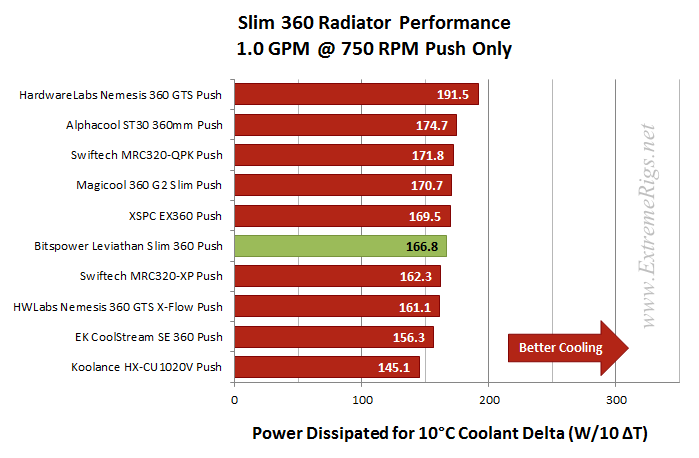 The BP-NLS360 finished mid-pack of the slim 360mm radiators tested in Push Only at 750 RPM. The clear winner was ~13% ahead at this data point.
The BP-NLS360 finished mid-pack of the slim 360mm radiators tested in Push Only at 750 RPM. The clear winner was ~13% ahead at this data point.
Now let’s look at 1300 rpm:
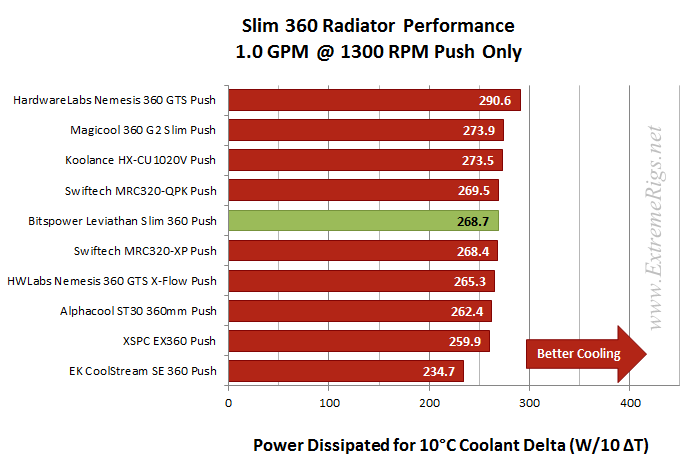 For Push Only 1300 the middle of the ranking table again has tightly grouped results. This is to be expected I suppose given the performance limitations of a slim core which they are all equipped with.
For Push Only 1300 the middle of the ranking table again has tightly grouped results. This is to be expected I suppose given the performance limitations of a slim core which they are all equipped with.
Now 1850 rpm Push Only:
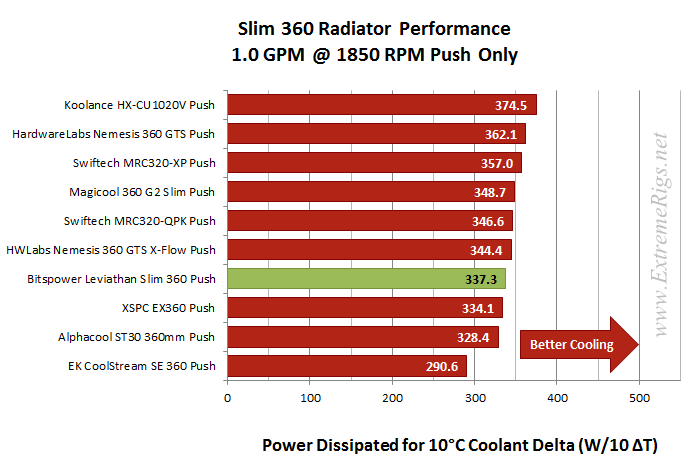 At 1850 rpm the BP-NLS360 drops a few ranking positions and we see a bit more separation between the contenders as subtle variations of each design show their strengths and weaknesses.
At 1850 rpm the BP-NLS360 drops a few ranking positions and we see a bit more separation between the contenders as subtle variations of each design show their strengths and weaknesses.
While not a stand out performer In Push Only, the BP-NLS360 did produce a solid enough data set with results that were competitive with the majority of the field at each fan speed.
Let’s find out how the BP-NLS360 performs with Push/Pull fans.
Push/Pull Data vs. Competition
For Push/Pull comparisons we display the plot and comment on the averaged results at each fan speed for the Slim 360mm radiators only. Individual ranking plots for each flow rate / fan speed are spoilered as are averaged results against all 360mm radiators.
Firstly the 750 rpm:
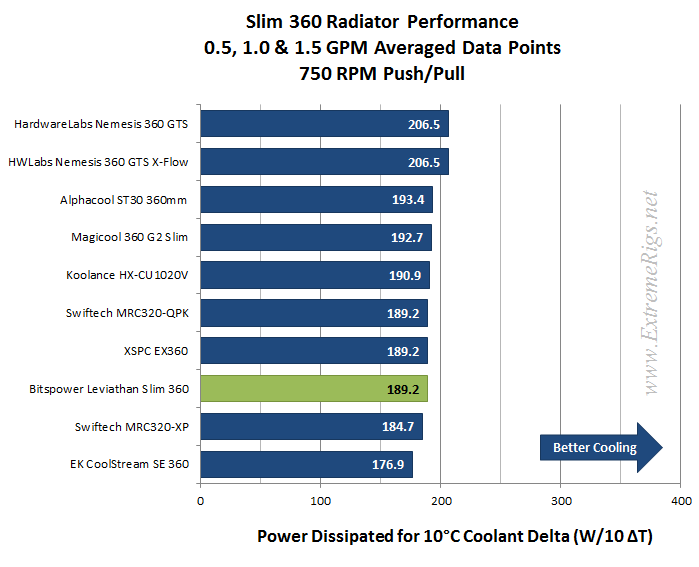 The BP-NLS360 lands in 3rd last position with a low speed Push/Pull fan assembly. There were two clear winners while the rest including the BP-NLS360 had very close results. The difference between 3rd and the BP-NLS360 for the averaged results was only ~2%.
The BP-NLS360 lands in 3rd last position with a low speed Push/Pull fan assembly. There were two clear winners while the rest including the BP-NLS360 had very close results. The difference between 3rd and the BP-NLS360 for the averaged results was only ~2%.
Let’s move to 1300 rpm:
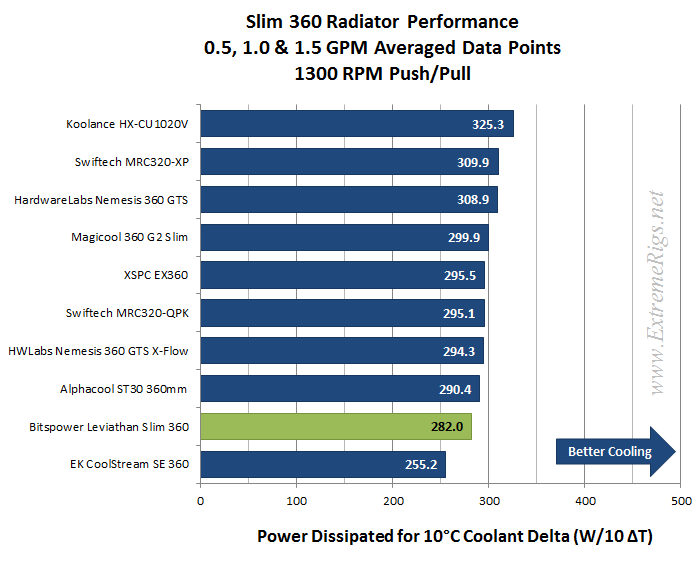 At 1300 rpm Push/Pull the BP-NLS360’s ranking drops and we now see more separation between the results. The Bitspower is now ~13% behind the best performer at this data point.
At 1300 rpm Push/Pull the BP-NLS360’s ranking drops and we now see more separation between the results. The Bitspower is now ~13% behind the best performer at this data point.
Now 1850 rpm:
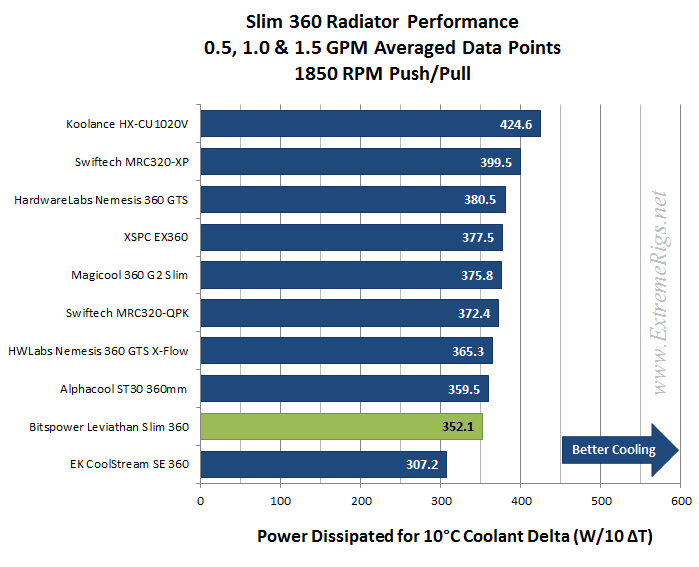 1850 rpm Push/Pull is possibly the most unlikely installation scenario for the BP-NLS360. It’s a set-up which we would not recommend using for Slim radiators. The benefits of Push/Pull on a slim rad aren’t great enough to warrant the extra space required, this is especially true as the fan speeds get higher. If you have 80mm of space available (slim rad + 2 fans) we would advise investigating a thicker radiator with a Push Only fan assembly. As in the Push/Pull 1300, the BP-NLS360 finished near the bottom the the group.
1850 rpm Push/Pull is possibly the most unlikely installation scenario for the BP-NLS360. It’s a set-up which we would not recommend using for Slim radiators. The benefits of Push/Pull on a slim rad aren’t great enough to warrant the extra space required, this is especially true as the fan speeds get higher. If you have 80mm of space available (slim rad + 2 fans) we would advise investigating a thicker radiator with a Push Only fan assembly. As in the Push/Pull 1300, the BP-NLS360 finished near the bottom the the group.
Let’s now combine the Push Only and Push/Pull results for our slim 360mm radiators at 1.0 GPM for each fan speed so we see both sets of results on the same plot. Sometimes these combined plots show up some points of interest, however they are long, so again a spoiler has been used.
From all the test results we created “Average Performance Factor” charts for both Push and Push/Pull. We then made a combined plot of the average called the “Master Performance Factor”. The radiator with the best cooling ability (W/10ΔT) at each rpm was awarded a score of 100. Each other radiators W/10ΔT result was scored as percentage of the top performer.
This way of looking at the comparison takes away any advantages that a radiator may have at higher or lower fan speeds and looks at an overall average. While this appears fair it does tend to favor those radiators that are all-rounders and those radiators which do very well at high RPM. Most users should be more focused on their specific use case.
Here are the BP-NLS360’s percentage scores at each data point:
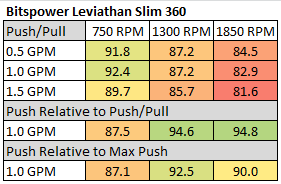 This table confirms that the BP-NLS360 was not one of the stronger performers. As the fan speeds increase the best performing radiator pulled further ahead.
This table confirms that the BP-NLS360 was not one of the stronger performers. As the fan speeds increase the best performing radiator pulled further ahead.
As these percentage scores are relative to the best performer at each data point, we again advise readers to cross reference specifications and results for each radiator and keep in mind your intended fan assembly and operating speed.
The percentage numbers in the table above offer another way of looking at the BP-NLS360’s results. But for our scoring system we need a way to reduce the categories while retaining the data. To do this we average the results for each fan assembly type giving us Averaged Performance Factors. We calculate this for Push Only, Push/Pull and finally an average of everything.
Firstly – the Push Only APF:
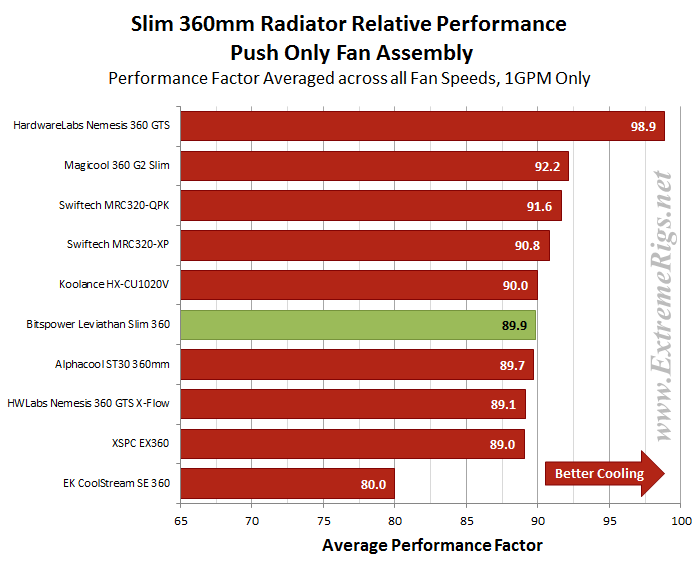 With an 89.9 % Averaged Push Only result the BP-NLS360 is the right in the middle of a closely grouped pack of 8 slim radiators, while one was clearly stronger than the rest, and one was much weaker.
With an 89.9 % Averaged Push Only result the BP-NLS360 is the right in the middle of a closely grouped pack of 8 slim radiators, while one was clearly stronger than the rest, and one was much weaker.
Now the Push/Pull APF:
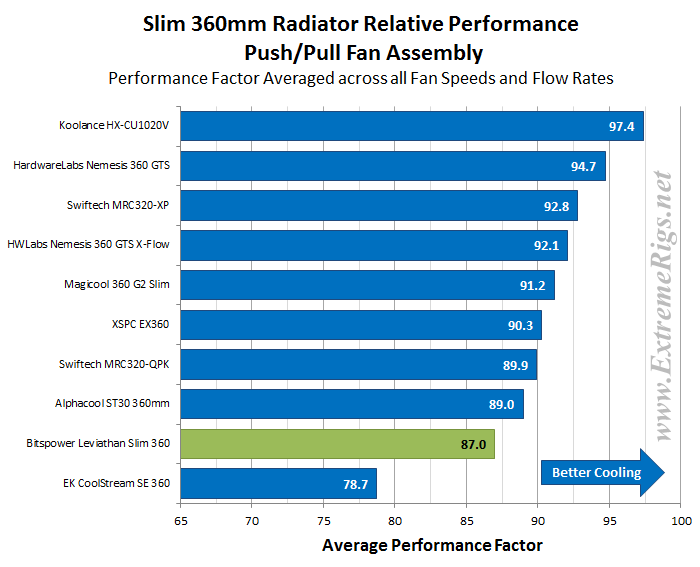 In the Push/Pull APF the BP-NLS360 dropped down in the rankings to 2nd last as we saw more separation between results.
In the Push/Pull APF the BP-NLS360 dropped down in the rankings to 2nd last as we saw more separation between results.
Finally for thermal performance we created the Master Performance Factor which is calculated from the averaged results of all the Push Only and Push/Pull thermal tests, at all fan speeds and flow rates.
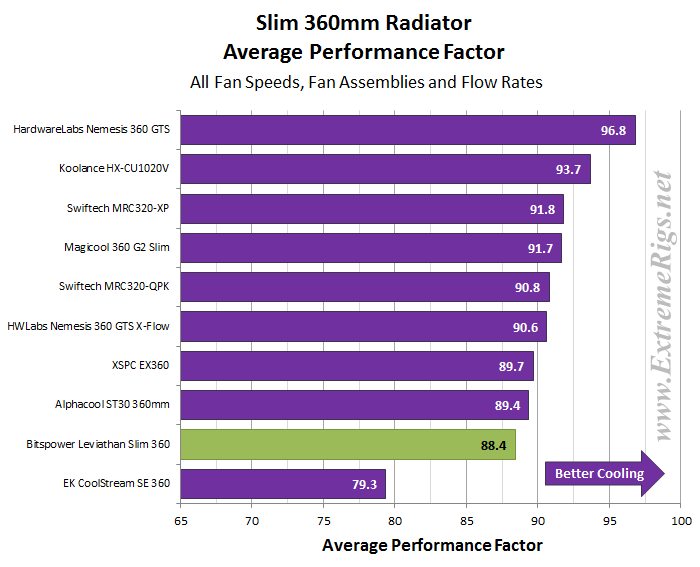 The MPF result of 88.4 and low ranking is mostly to do with the BP-NLS360’s below averaged Push/Pull performance results. As Push/Pull is not a recommended fan set-up for a slim radiator, this is the probably performance chart of least significance, although it makes up a very large part of the scoring system. As all the radiators are scored on the same system we do believe the scoring system remains fair.
The MPF result of 88.4 and low ranking is mostly to do with the BP-NLS360’s below averaged Push/Pull performance results. As Push/Pull is not a recommended fan set-up for a slim radiator, this is the probably performance chart of least significance, although it makes up a very large part of the scoring system. As all the radiators are scored on the same system we do believe the scoring system remains fair.
Space Efficiency
The BP-NLS360’s space efficiency vs. performance might be a breath of fresh air as thinner rads almost always produce better results here than their thicker counterparts. When isolating just the slim radiators, actual difference appears more than it is because in reality all slim radiators including the BP-NLS360 use the space very efficiently.
We have used the Average Performance Factor results from the charts above to compile two plots which shows us how it compares to the other rads in terms of performance Vs. space taken.
Firstly is radiator thickness Vs. APF.
Here the combined APF (MPF) scores were divided by the only radiator thickness, with the highest (most space efficient) issued a score of 100. Each of the other radiators results was converted to a percentage of the most space efficient radiator’s score.
Note that part of the Leviathan’s space efficiency is also it’s narrow width which isn’t included in this metric.
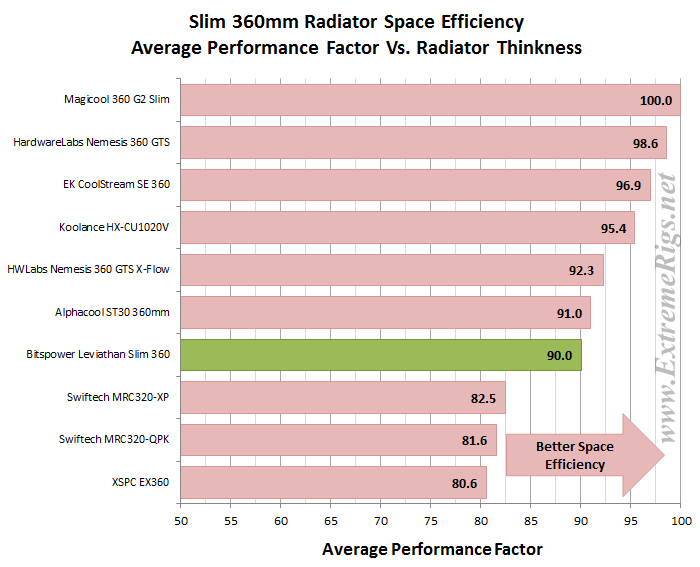
The results end almost in order of thinnest to thickest. This is particularly true when comparing to all radiators and not just slim results.
Next we took the APF results for Push/Pull and divided it by the total thickness including the fans and applied the same scoring system. For the Push Only we used the Push Only Vs Push/Pull comparative results and applied the same scoring system when compared against the Push/Pull.
The rankings are ordered for Push Only as that is the most efficient fan assembly and each radiator’s Push/Pull result are placed un-ordered, just below it’s ranked Push Only score.
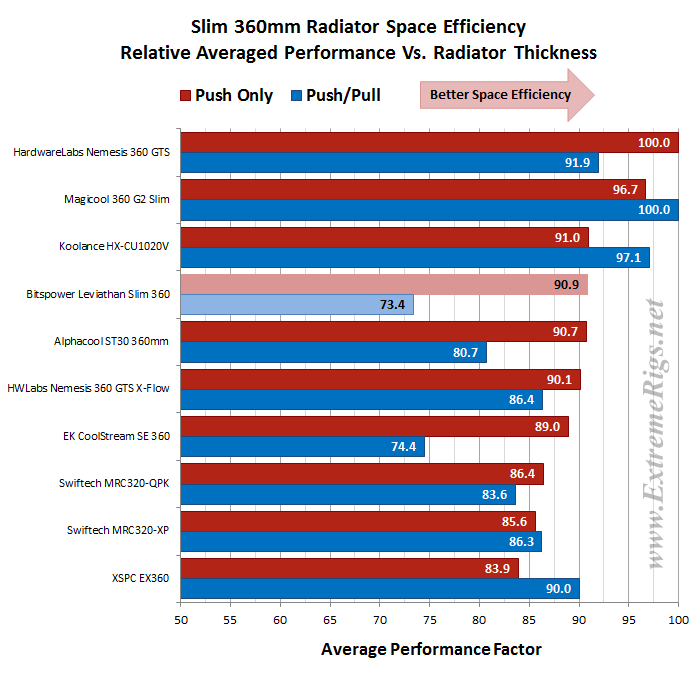 This plot is likely the most useful for readers of the 2 plots for space efficiency even though it is harder to decipher, especially the Push/Pull rankings. With fan thickness factored in the BP-NLS360 finishes 4th for Push Only but it’s 73.4 Push/Pull result is the worst of the group.
This plot is likely the most useful for readers of the 2 plots for space efficiency even though it is harder to decipher, especially the Push/Pull rankings. With fan thickness factored in the BP-NLS360 finishes 4th for Push Only but it’s 73.4 Push/Pull result is the worst of the group.
Value Factor
While our APF’s are still fresh in mind, let’s now look at some performance results vs radiator price to show which of the 360mm radiators might offer the best bang for your buck. Each radiator’s combined APF (MPF) scores were divided by the radiator cost and again we applied our scoring system of percentage Vs. the best performer of the category.
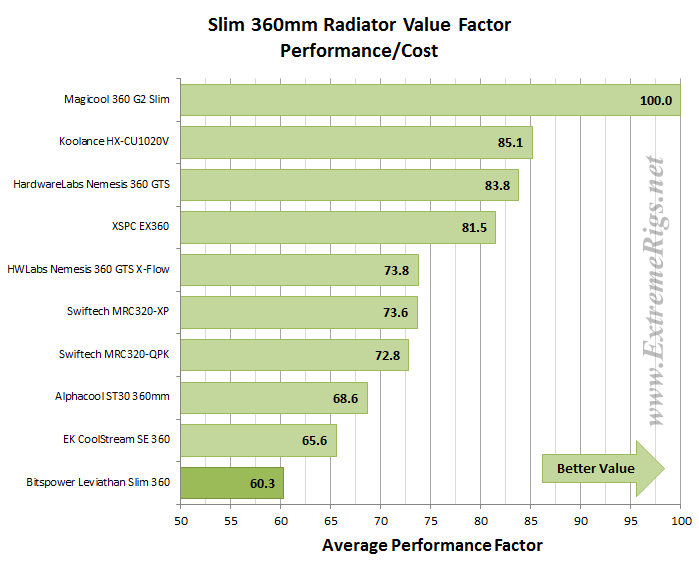 The BP-NLS360’s Value Factor turns out to be very low. This is due to the Bitspower Leviathan Slim 360 being the most expensive radiator of the Slim 360mm test group combined with it’s weak overall performance.
The BP-NLS360’s Value Factor turns out to be very low. This is due to the Bitspower Leviathan Slim 360 being the most expensive radiator of the Slim 360mm test group combined with it’s weak overall performance.
Next Up – Summary!







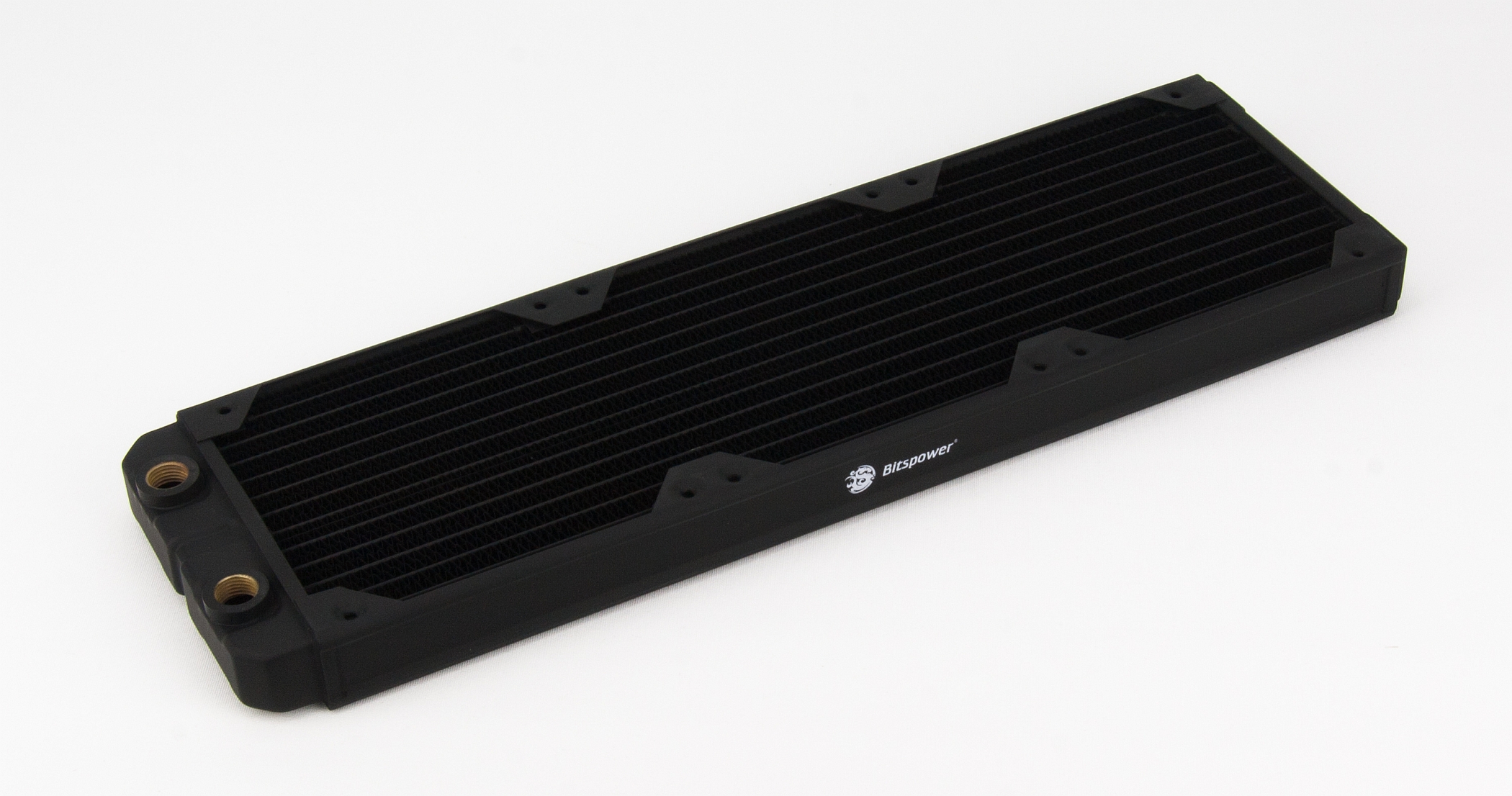

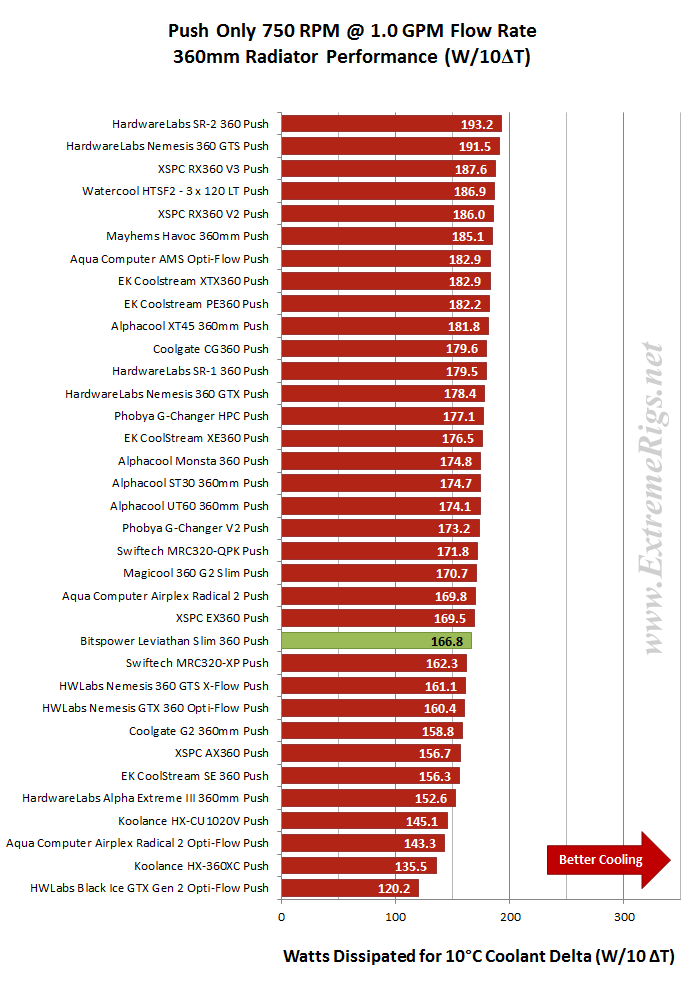
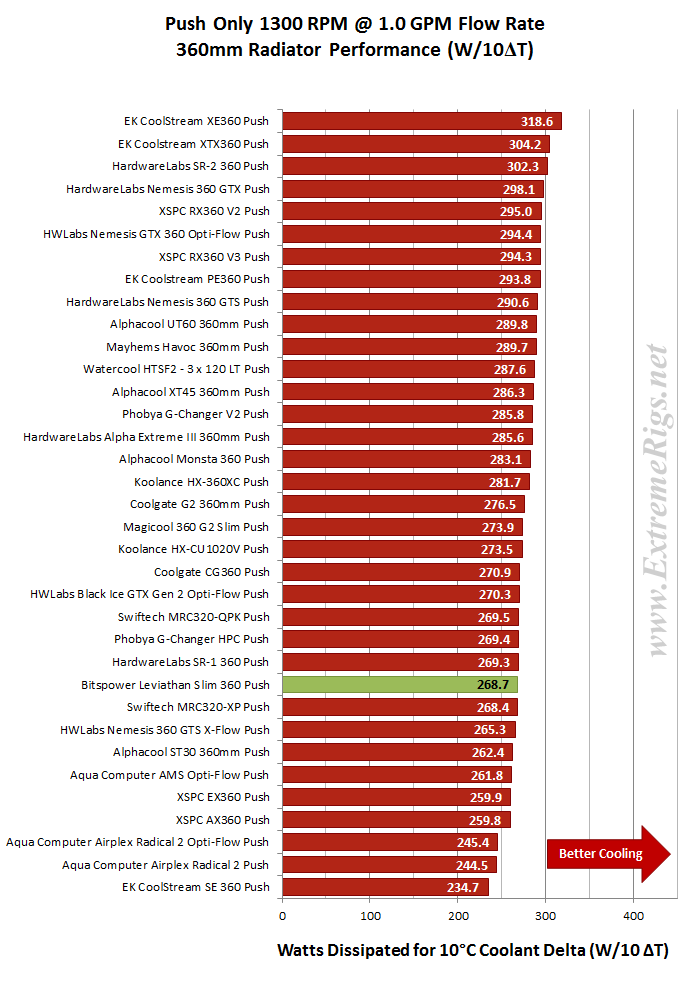
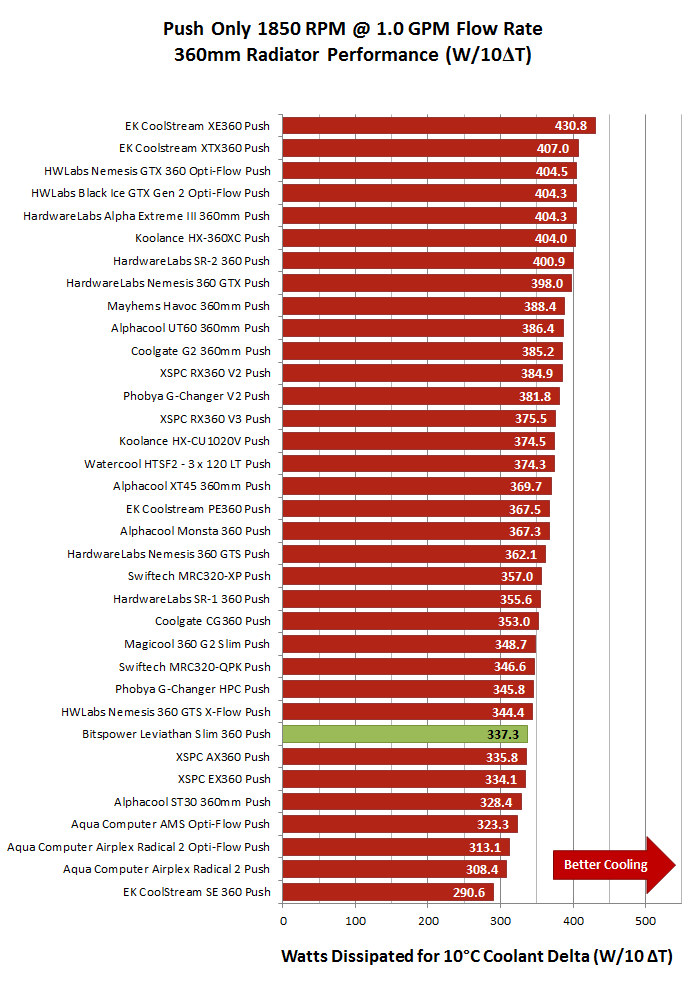
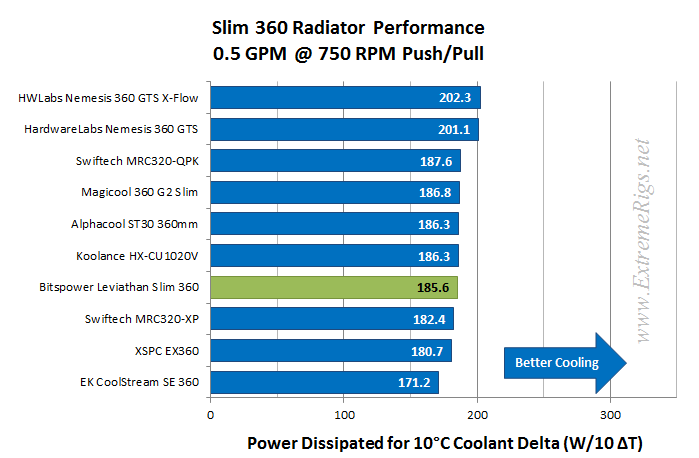
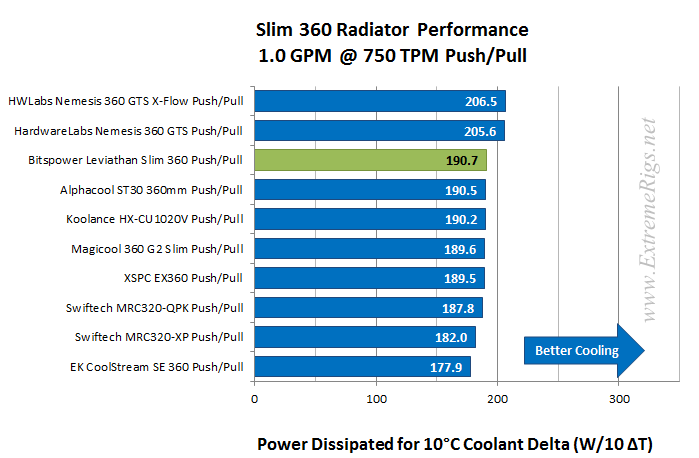
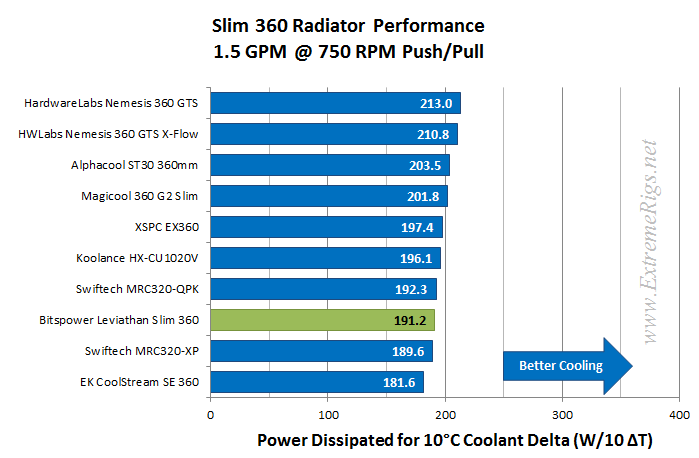
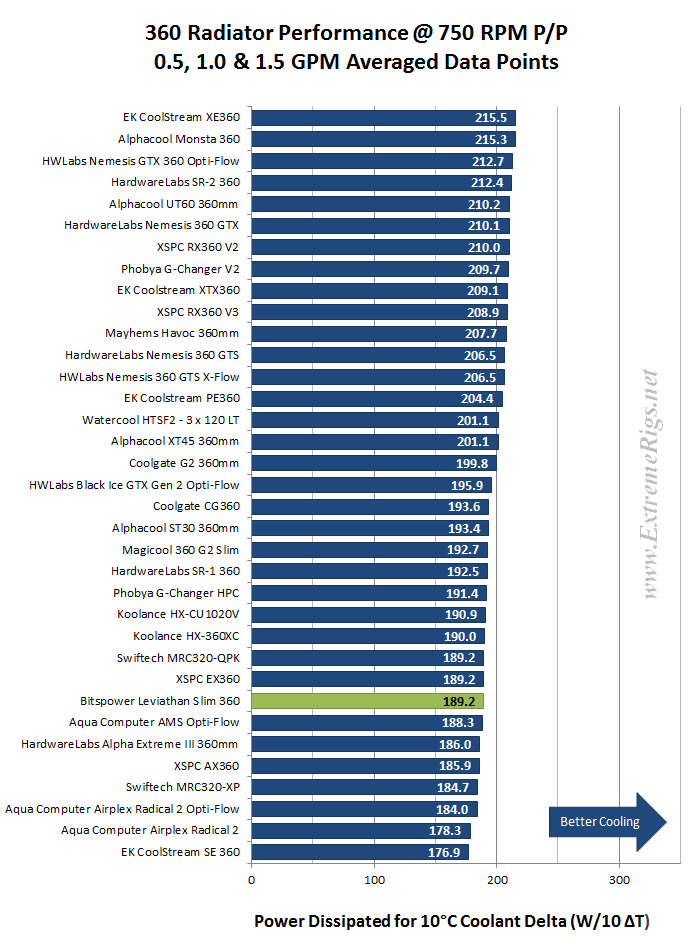
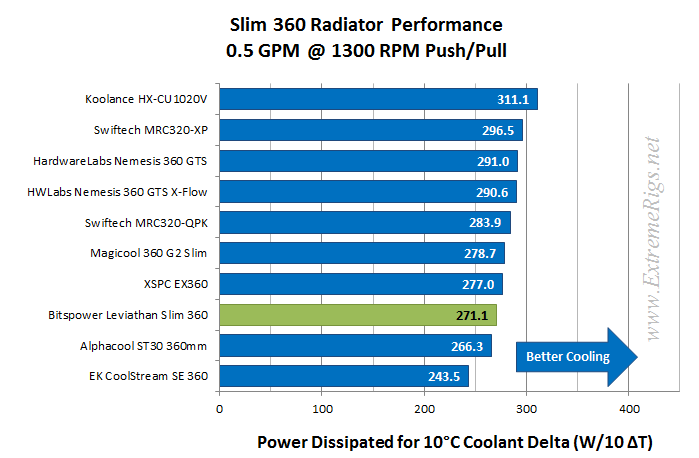

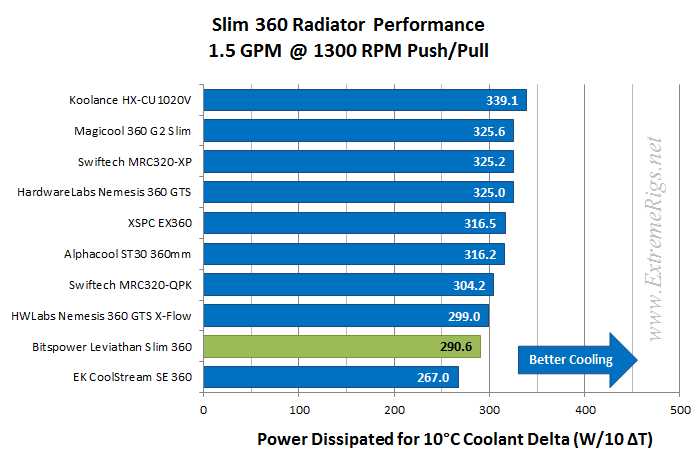
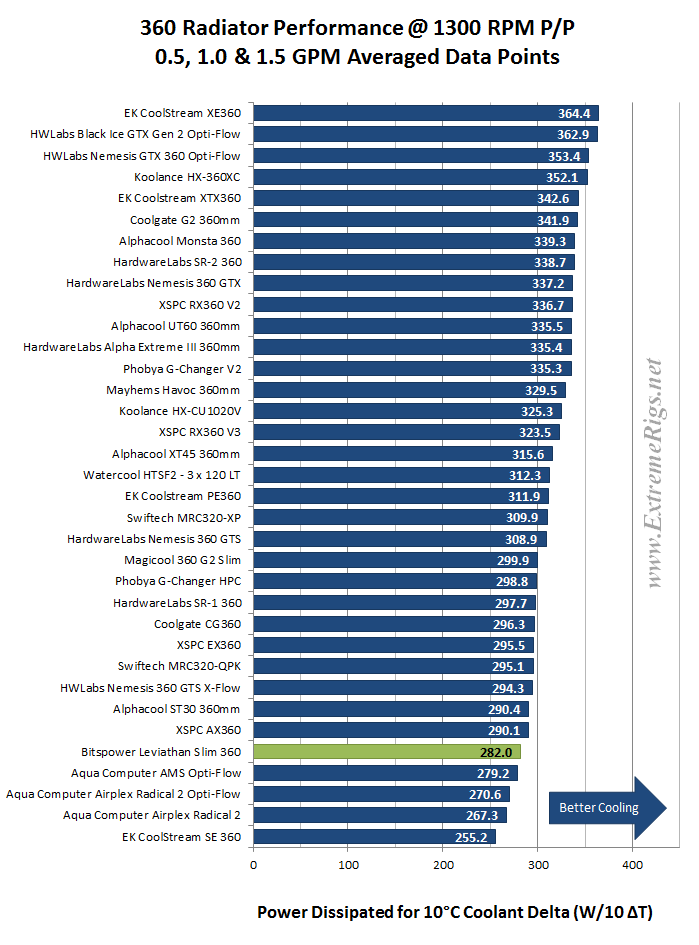
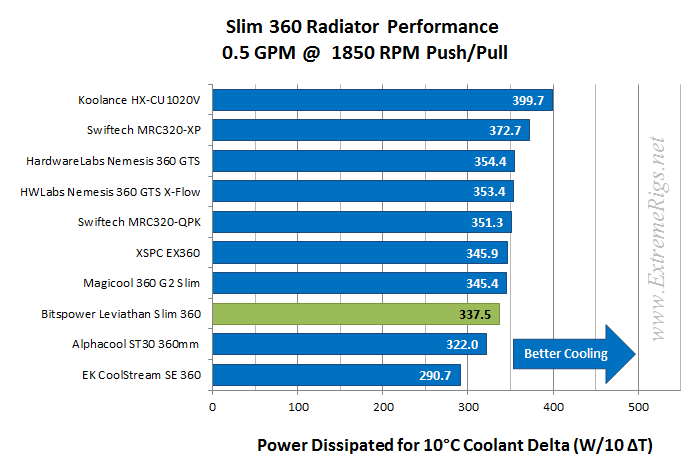
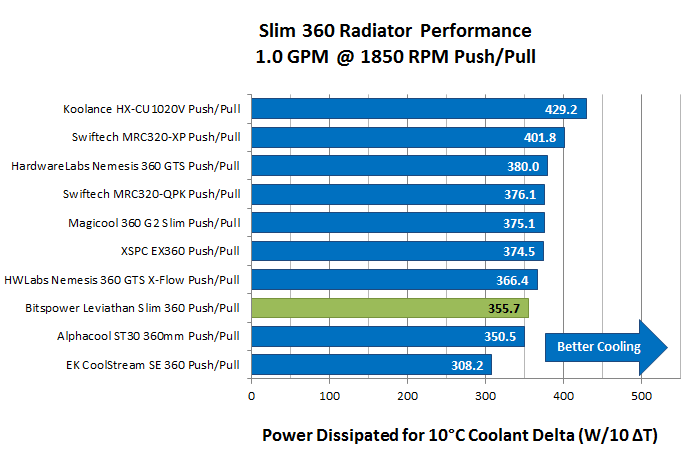
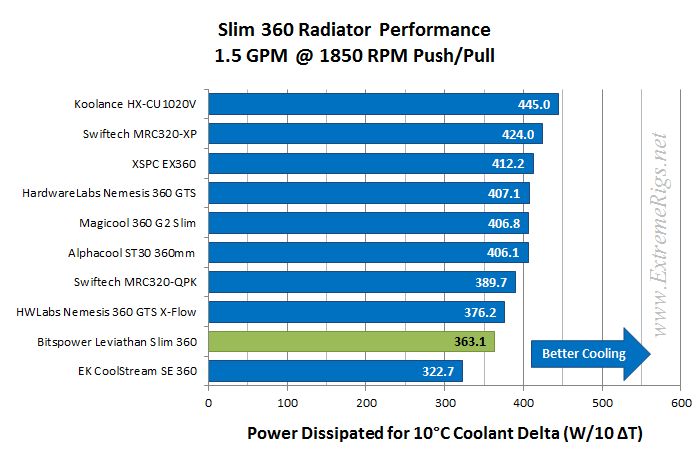
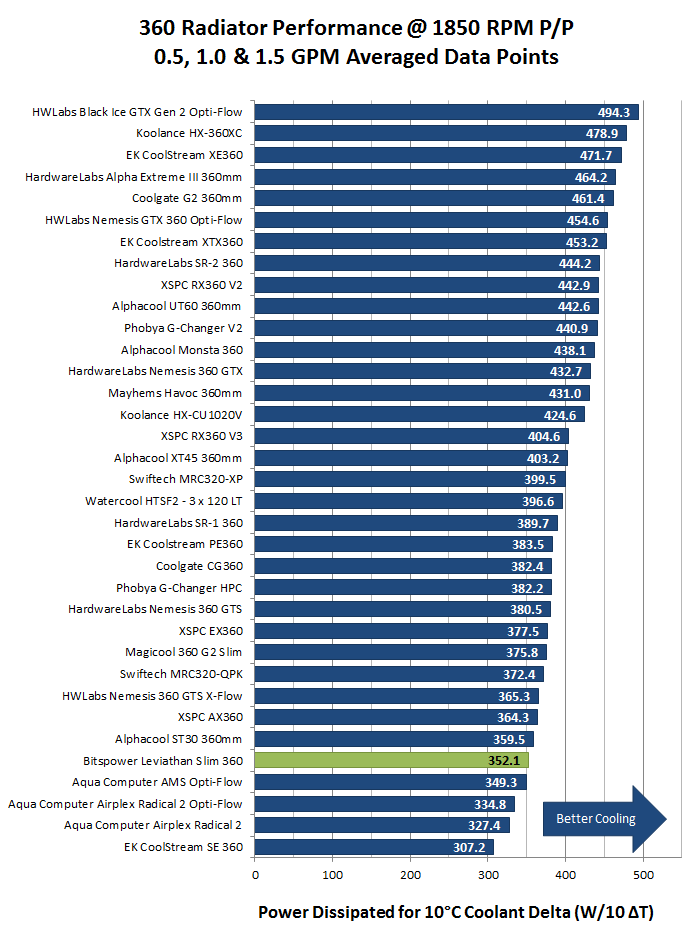
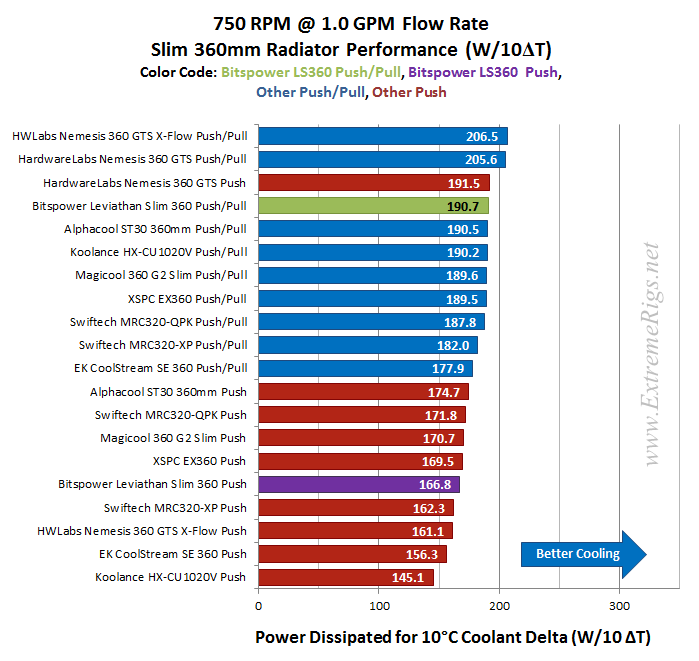
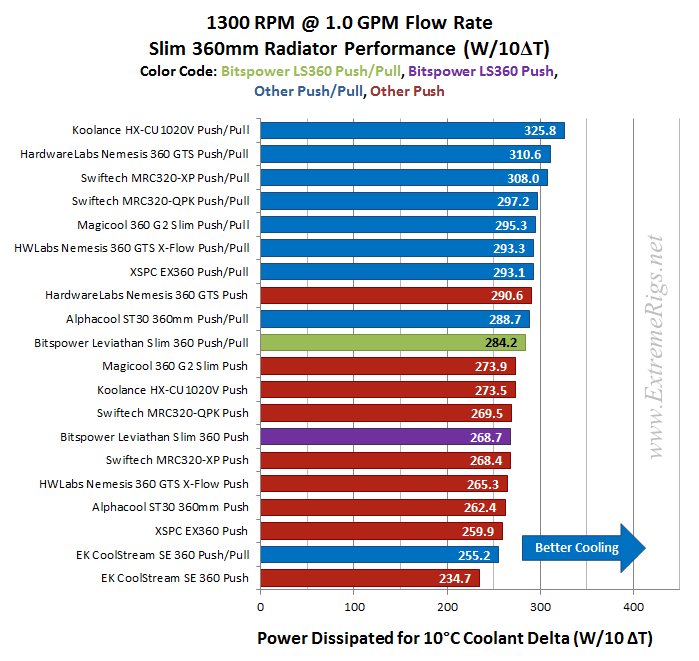
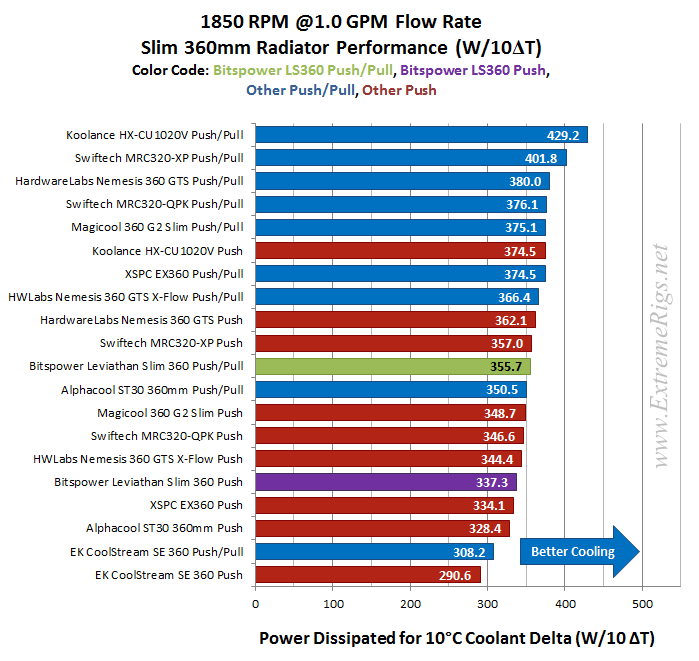
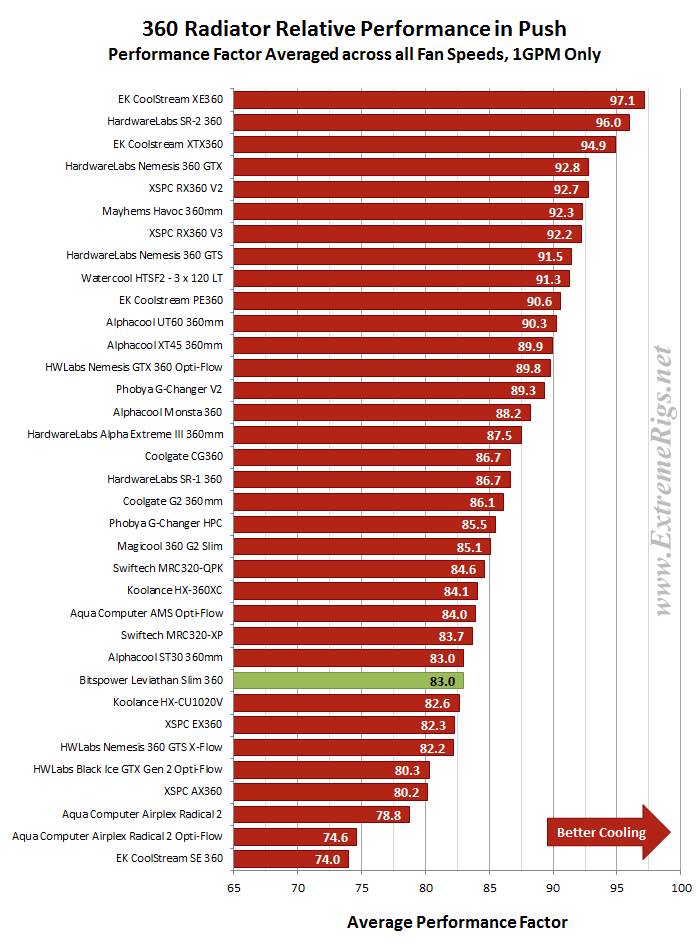
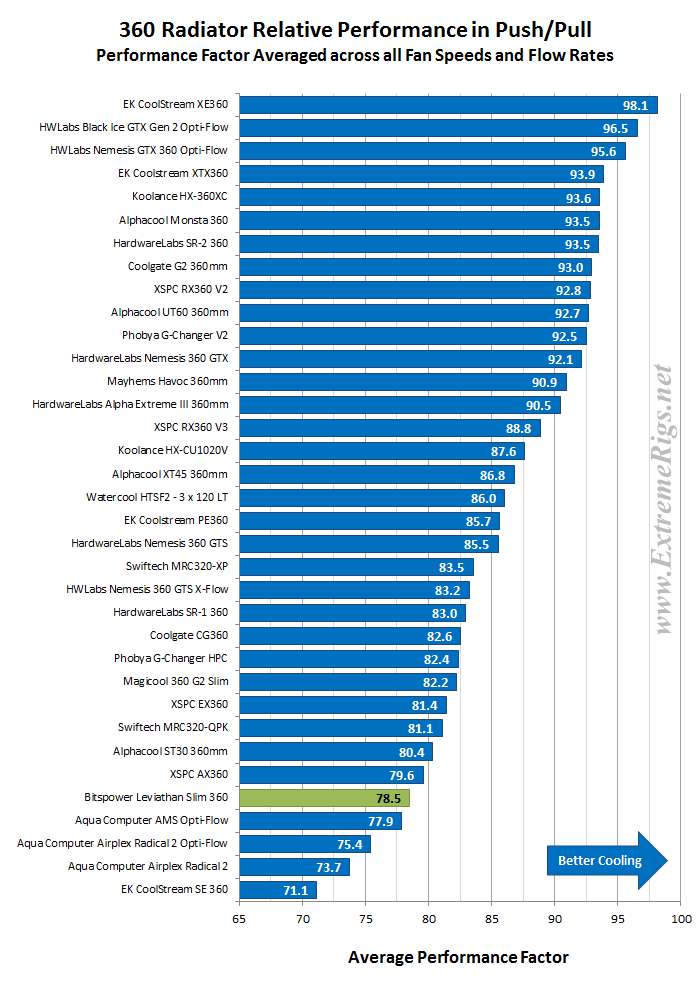
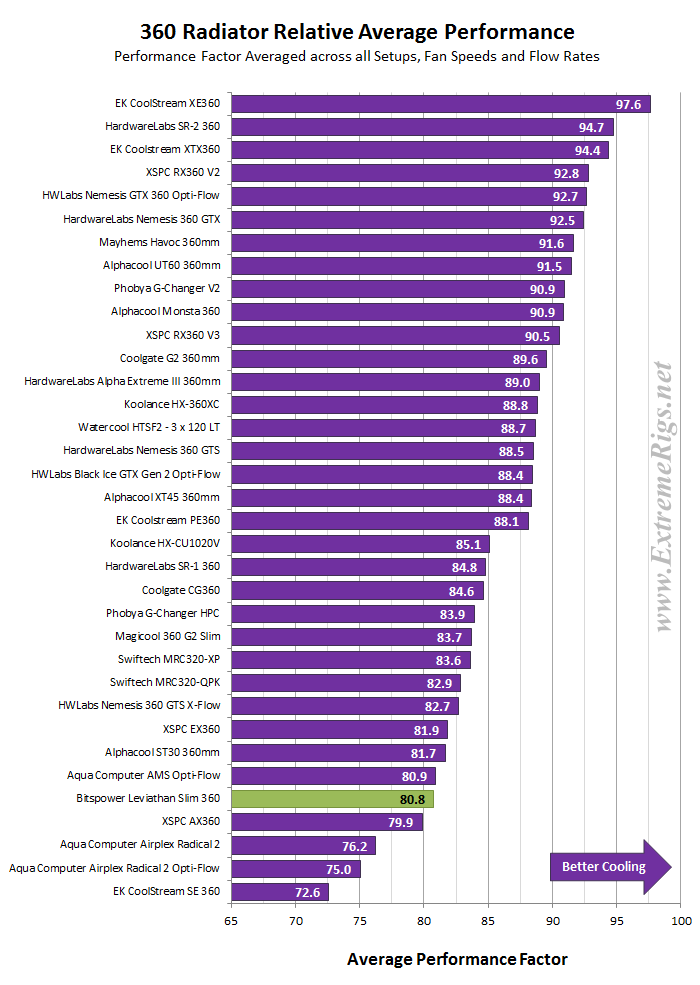
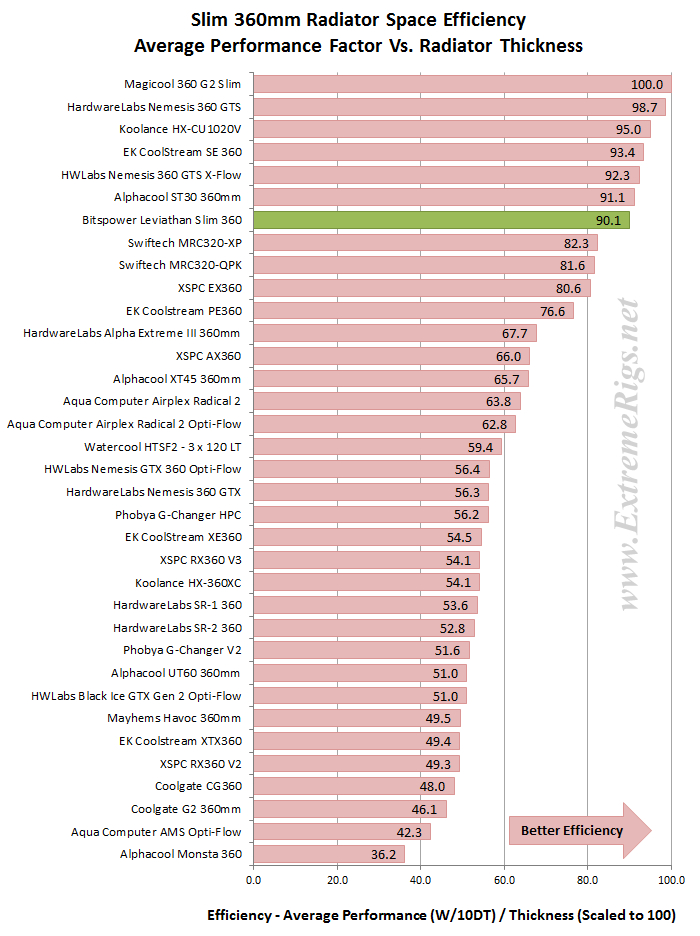
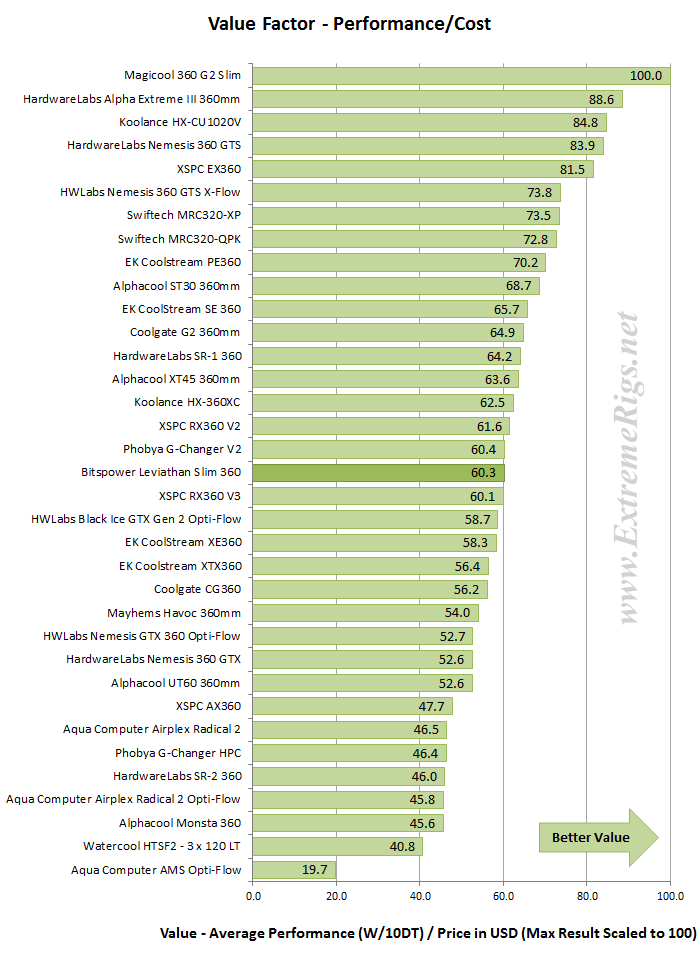



Another great and detailed review from you guys.
It’s interesting that the Leviathan *cough* L-series *cough* is noticeably not as good as the 360GTS considering similar characteristics with what looks to be a shroud with inverted sides as the only variation. I was considering getting an L-Series but I think for a small, slim radiator to fit in offset top mounts like my Arc Mini R2 I’d be more likely to look at the Magicool G2 Slim, or Darkside LP360 versus this. The Magicool seems to be a sweet spot radiator for slim versus performance. The original GTS seems to be top but the 133mm width can occasionally cause problems with clearance in cases with said offset top mounts.
I love that you summarize the thermal performance with immediate competition so I don’t have to flip back and forth between tabs to compare slim or thick radiators.
Keep up the great work!
I send all my water cooling buddies here when they ask about “is this enough radiator for my setup?”
Comments are closed.